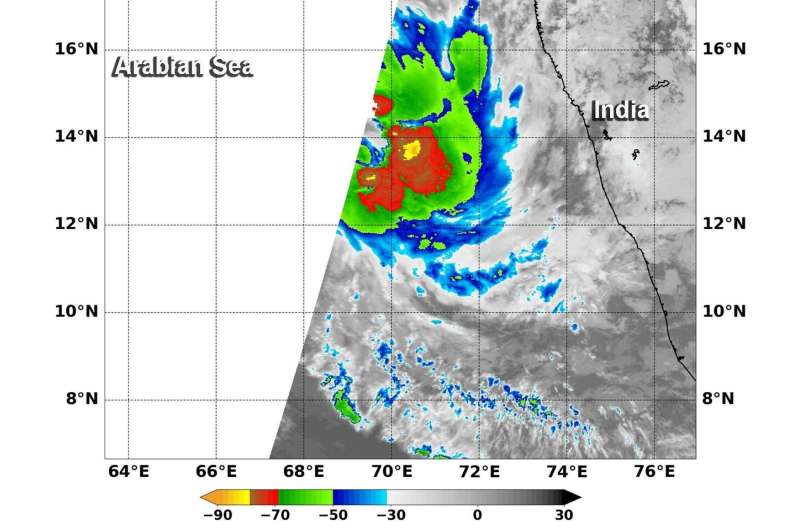On Dec. 3, 2019 at 12 pm. EST (1700 UTC) the MODIS instrument that flies aboard NASA's Terra satellite showed the southeastern quadrant of newly formed Tropical Storm 07A where cloud top temperatures (in yellow) were as cold as or colder than minus 80 degrees Fahrenheit (minus 62.2 Celsius). Credit: NASA/NRL
Tropical Storm 07A has developed in the eastern Arabian Sea, one day after Tropical Storm 06A developed in the western part of the sea. Infrared imagery from an instrument aboard Terra revealed that very high, powerful storms with very cold cloud top temperatures were southwest of the center.
Tropical Storm 07A developed on Dec. 2 from a low-pressure area designated as System 91A. The storm consolidated into a tropical storm today and was renamed 07A.
Tropical cyclones are made of up hundreds of thunderstorms, and infrared data can show where the strongest storms are located. They can do with infrared data that provides temperature information. The strongest thunderstorms that reach highest into the atmosphere have the coldest cloud top temperatures.
On Dec. 3 at 12 pm. EST (1700 UTC) the Moderate Resolution Imaging Spectroradiometer or MODIS instrument that flies aboard NASA's Terra satellite showed the southeastern quadrant of newly formed Tropical Storm 07A where cloud top temperatures (in yellow) were as cold as or colder than minus 80 degrees Fahrenheit (minus 62.2 Celsius). NASA research has found that cloud top temperatures that cold indicate strong storms with the potential to generate heavy rainfall.
On Dec. 3 at 10 a.m. EDT (1500 UTC), Tropical Storm 07A had maximum sustained winds near 35 knots (40 mph /65 kph). It was located near latitude 13.4 degrees north and longitude 70.2 degrees east, about 367 nautical miles south-southwest of Mumbai, India.
Forecasters at the Joint Typhoon Warning Center expect 07A will move northwest. The system is not expected to intensify and is expected to dissipate in a day or so.
Provided by NASA's Goddard Space Flight Center
























